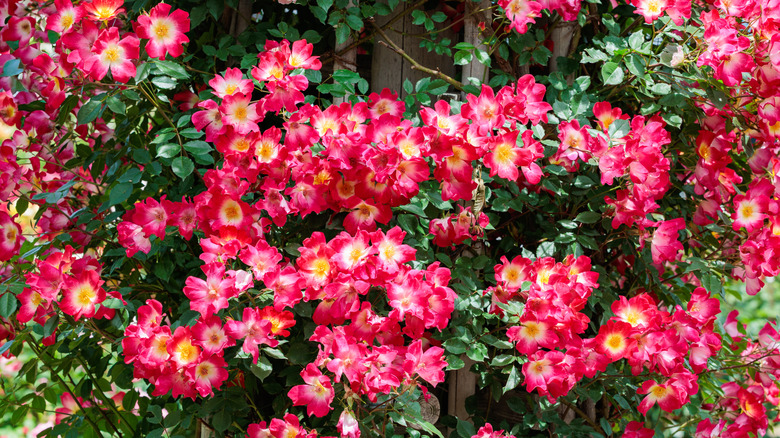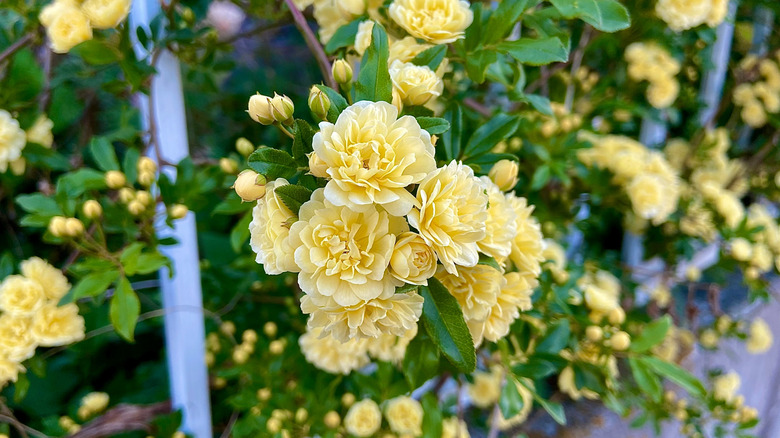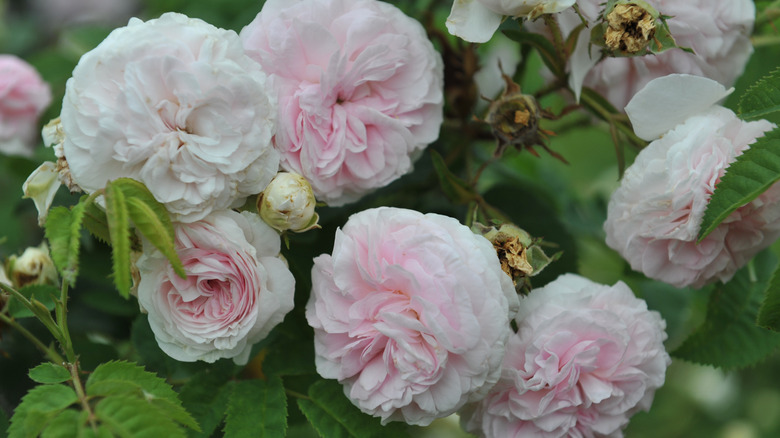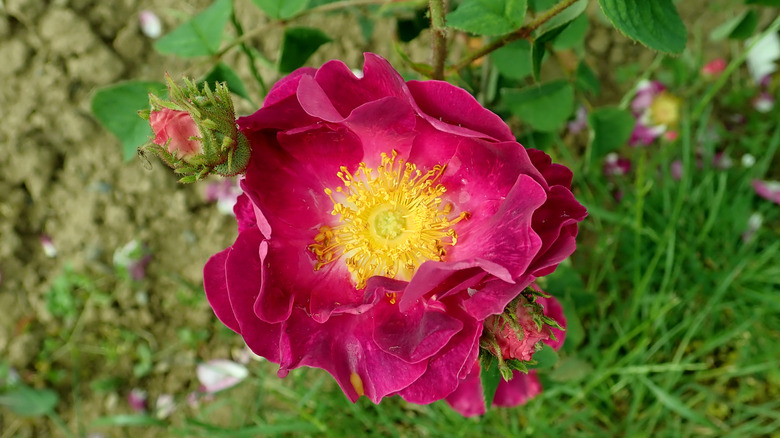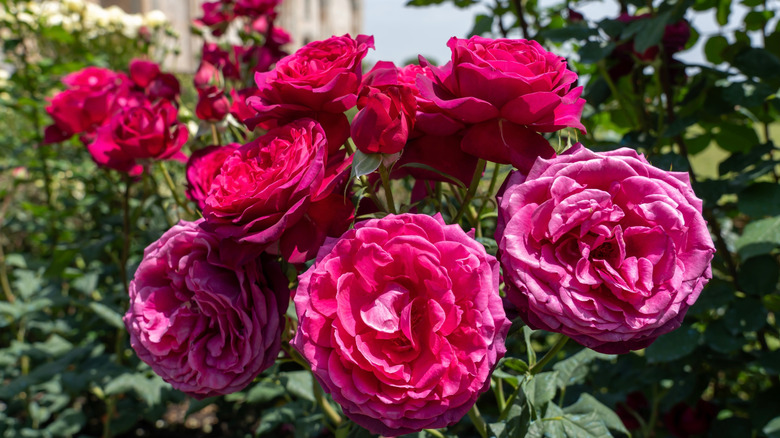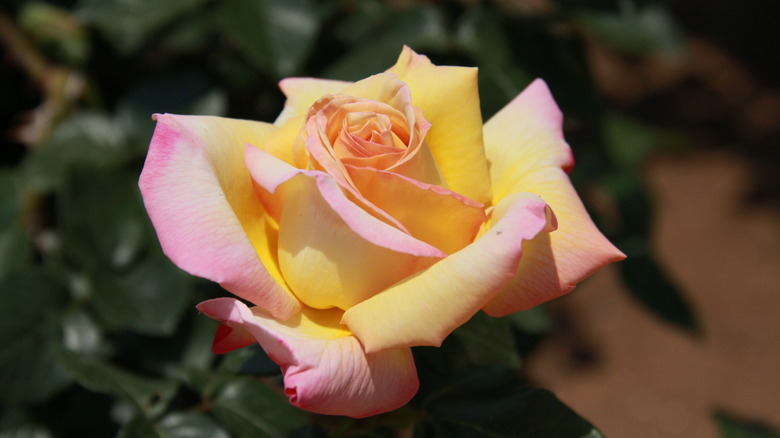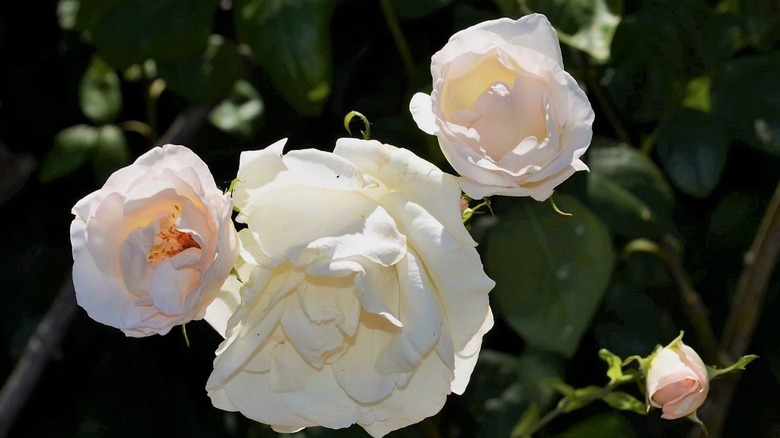10 Varieties Of Roses You Shouldn't Be Cutting Back In The Fall
Roses are an iconic addition to any yard, with their classic blooms bringing timeless elegance into your landscaping. These beautiful flowers need attention over the seasons to help them thrive, from pruning to feeding to deadheading. Most rose bushes need pruning around once a year, but it is necessary to prune them at the right time according to their variety and type. Certain roses will do well with a fall prune, as this allows you to take off any long stems and tidy them up for winter. However, some varieties should not be cut back in the fall.
Pruning in the fall can be detrimental to types of roses that are susceptible to dieback. Pruning opens their tissue and makes them vulnerable, potentially causing problems during the winter months. Furthermore, as certain types of roses bloom on old wood, cutting them back in the fall will reduce the number of flowers you have the following year. Knowing which roses to avoid tidying up when you do your fall yard tasks means that you will be set up for another year of beautiful blooms and healthy plants.
American Pillar rose
This beautiful rose variety has stunning, bright pink flowers that bloom in clusters in the summertime. Although these flowers only appear once per year, the American Pillar rose is beloved by many for its size, hardiness, and vigor. If you have an American Pillar (Rosa 'American Pillar') in your garden, avoid pruning it in the fall because it blooms on old wood. Instead, prune this variety right after flowering to remove any leggy or unattractive canes. You can also prune it in the late winter if it needs some attention and tidying up.
Lady Banks rose
With its creamy yellow double blooms, the Lady Banks rose (Rosa banksiae) is a fantastic choice for a larger rose bush. As this variety can grow up to 40 feet, you probably want to prune it most years to keep it manageable. But as it blooms on old wood, you should avoid pruning it in the fall. Doing so may mean fewer stunning flowers next year. Instead, you should prune this variety after it has bloomed. However, you only really need to do so if you want to reduce its size.
Summer damask rose
The summer damask rose (Rosa x damascena) has warm pink, fragrant flowers that decorate the shrub in the summer time. It is a hybrid shrub rose, perfect for brightening up borders and adding color to garden beds. This variety only blooms once and should be pruned shortly after, as it blooms on old wood. You may wish to leave the vibrant red rose hips that appear once the shrub has flowered to keep some intrigue and color in your yard, even after the petals have faded.
Felicite Parmentier rose
The Felicite Parmentier rose (Rosa 'Felicite Parmentier') is a dense, upright flower with light pink, tight blooms. Bred in the 1800s, this rose is an old-fashioned alba variety that doesn't need much pruning. However, pruning in the fall should be avoided as they flower on old wood. You should prune the Felicite Parmentier rose just after flowering, doing so lightly during the first few years. After a few years, this rose can handle up to a third of its size being pruned after flowering to manage its height and spread.
La Belle Sultane rose
A stunning rose with rich, deep purple blooms, the La Belle Sultane rose (Rosa 'La Belle Sultane') makes an impact in any garden it is growing in. A large, upright variety, this rose brings elegance and structure to your yard. As this beauty is a once-blooming gallica, it should not be pruned in the fall. Instead, you should keep pruning to a minimum and only do so after it has flowered. When pruning after blooming, take off any dead or damaged stems and shape the bush.
Charles de Mills rose
With its large, luscious blooms that look as delicate as tissue paper, the Charles de Mills rose (Rosa 'Charles de Mills') is a popular variety that was introduced in the 1700s. As a one-blooming gallica, you shouldn't cut back your Charles de Mills rose in the fall. Instead, do any work on it in late summer after it has flowered. You should avoid doing any hard pruning to this rose unless you really have to, as it can affect its shape. Perform light pruning to remove dead, diseased, or damaged branches.
Double delight rose
The double delight rose (Rosa 'Andeli' or Rosa 'Double Delight') has beautiful ombre petals in hues of white and red, making it an interesting cultivar to grow. However, you should avoid cutting this rose back in the fall. As a hybrid tea rose, it is quite susceptible to winter injury and damage, including dieback. This means that a fall prune can leave it open to problems over the colder months. Lightly prune this variety in spring to tidy it up and remove any broken or damaged stems from winter.
Peace rose
The Peace rose (rosa 'Peace') is another popular hybrid tea variety. Its blooms look as if painted by an artist, with delicate shades of gold, yellow, and pink that create a breathtaking effect. However, as a hybrid tea rose, pruning the Peace rose in the fall can mean it suffers more during the winter. You need to focus on winter protection in the later months of the year and do what you can to protect your roses from frost and weather damage. Then, when spring comes, you can cut back and tidy up the plant.
Alba Maxima rose
The creamy, clustered double flowers of the Alba Maxima rose (Rosa × alba 'Alba Maxima') are quintessentially old-school blooms. As an alba variety of rose, this shrub blooms on old wood and therefore should not be pruned in the fall. Do any work on them after they have flowered in the summer. You don't need to cut these roses back too heavily, as this sometimes can do more harm than good. Lightly prune them to enhance their shape and get rid of any dead wood, and thin them out if necessary.
Madame Alfred Carrière rose
The Madame Alfred Carrière rose (Rosa 'Madame Alfred Carrière') is a stunning climbing rose variety that is covered in beautiful blooms in summer and fall. The cream flowers are fragrant and impressive, fitting perfectly into both formal and informal gardens. The Madame Alfred Carrière rose is a noisette rose, and these varieties are quite tender. So, avoid pruning them in the fall as it may leave them vulnerable to winter damage. Do any cutting back in January to remove dead or damaged wood.

